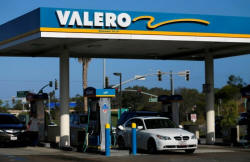|
Cruel summer for U.S.
refiners as margins tank
 Send a link to a friend
Send a link to a friend
 [July 07, 2016]
By Jarrett Renshaw and Devika Krishna Kumar [July 07, 2016]
By Jarrett Renshaw and Devika Krishna Kumar
NEW YORK (Reuters) - Summer driving season
is in full swing and American motorists are filling their tanks at a
healthy clip, but that is not swelling the profit margins as much as
usual at U.S. independent oil refiners such as PBF Energy Inc and Valero
Energy Corp.
In April, executives shrugged off the industry’s lousy first quarter as
an aberration that would be remedied this summer.
“We still are bullish gasoline and bullish octane," PBF CEO Tom Nimbley
told investors in an earnings call back then. “The driving season really
hasn't hit that hard yet.”
Nimbley was right about the surging summer demand. But refiner margins
are still being squeezed as gasoline and diesel inventories stubbornly
sit well above five-year averages.
Summer gasoline demand usually fattens margins for refiners with
seasonally high levels for the crack spread, the premium of a barrel of
gasoline over a barrel of crude oil.
That will not happen this year, said analysts who expect the situation
to remain bleak in the weeks ahead unless there are large drawdowns in
inventories.

Late on Wednesday, the American Petroleum Institute, an industry group,
assuaged some of those concerns, reporting a 3.6-million-barrel drawdown
in gasoline stocks. Yet inventories remain much higher than they were
last year at this time, and analysts have slashed earnings estimates for
big U.S. refiners who report second-quarter results in coming weeks.
The situation is so dire that U.S. East Coast refineries have been
cutting production. Refiners on the East Coast, known as "PADD 1" by the
U.S. Energy Department, are typically the first to feel a profit pinch,
because their margins tend to be thinner than those of other regions.
“PADD 1 is a holy mess,” said Andrew Lebow, senior partner at Commodity
Research Group in Darien, Connecticut. “It is very unusual. If a market
becomes extremely oversupplied, like PADD 1, they are going to have to
cut runs.”
The U.S. gasoline crack spread <1RBc1-CLc1>, a proxy for refiner
margins, has dropped 34 percent in two weeks. On Wednesday, it hit a
five-year low for this time of year of $13.10 a barrel. That is less
than half the crack spread of $28 a barrel at this time last year.
"An RBOB crack trading 13 bucks in the middle of driving season is
unheard of," said one trader.
East Coast gasoline stocks hit a record 72.4 million barrels, about 17
percent higher than the same time last year, data from the U.S. Energy
Department showed last week. Overall, U.S. gasoline stocks were at 239
million barrels in the week to June 24, nearly 10 percent higher than
last year and 15 million barrels more than the five-year average.
The glut is so extreme that several tankers full of products were forced
to sit idle in New York Harbor recently, waiting to unload.
[to top of second column] |

A Valero gas station is shown in Encinitas, California, U.S., May 2,
2016. REUTERS/Mike Blake

Inventories have grown despite evidence that U.S. motor travel continues to
surge. Analysts noted that U.S. refiners switched to maximum gasoline mode
earlier than usual during a fleeting moment of high margins in the early part of
2016. Imports also have been higher than normal in recent weeks, adding to the
glut.
John Auers, executive vice president at Turner, Mason & Co, a Dallas-based
consultancy, said he remains bullish on gasoline demand and refining margins
this summer, noting that gasoline and diesel inventories can draw down just as
fast they fill up.
“I think we will see some significant drawdowns in July and August, and that
will help margins,” Auers said. “I think $50 a barrel for crude oil will be the
high water mark, so gas prices will remain low and we will have a record driving
season this summer."
He warned that if inventories remain historically high at the end of the summer,
refiners could be forced to cut production significantly to account for weaker
seasonal demand.
The 10 largest independent U.S. refiners booked a combined net income of $944
million in the first quarter, down 74 percent from a year earlier, a Reuters
analysis showed. That put profits on track to be much less than the annual level
of more than $10.6 billion in the past five years.
Auers estimated that second-quarter margins would come in as the lowest for this
normally profitable quarter in at least five years. Over the last 30 days,
estimates for second-quarter earnings have fallen 17 to 20 percent for four of
the major U.S. refiners, Phillips 66, Valero Energy, Marathon Petroleum
and Tesoro, according to Thomson Reuters StarMine.

The S&P 500 oil & gas refining & marketing sub-index <.SPLRCENRM>, composed of
those four companies, has lost 22 percent this year.
(Editing by David Gregorio)
[© 2016 Thomson Reuters. All rights
reserved.] Copyright 2016 Reuters. All rights reserved. This material may not be published,
broadcast, rewritten or redistributed. |